Believe it or not, Back-to-School marks the unofficial start of the annual shopping season – not to be confused with the start of the holiday shopping season, which is Black Friday. That’s a different thing. Shopping season kicks off with back-to-school deals that generally start showing up right after Independence Day.
You may have already noticed a growing selection of school uniforms at your local mega store. This time of year, they may be butted up against the swimsuits but they’re there, and their presence is a telltale sign it’s time to start mapping out your back-to-school 2019 marketing campaign.
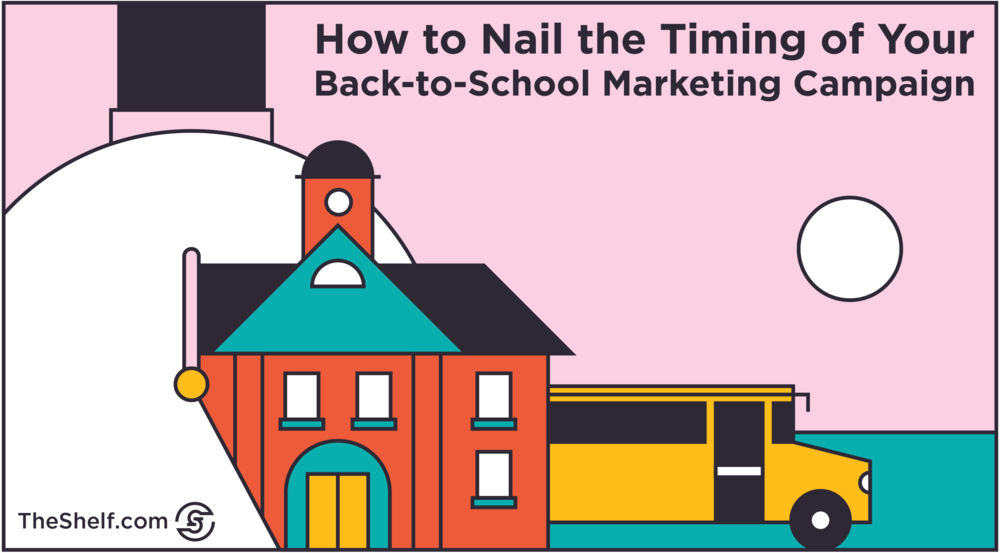
Starting a Little Early This Year, Aren’t We?
Yes and no. Yes, it seems early. I’m actually penning this sentence on June 13th, which means… it’s the end of spring – not even summer yet. So, why am I harping on you about rolling out a campaign for a fall retail event?
Well, for a couple of reasons…
REASON 1: CONSUMERS ARE STARTING THEIR BACK-TO-SCHOOL SHOPPING EARLIER
Back-to-school shopping has gone the way of holiday shopping – it’s starting earlier. American families will spend hundreds of millions of dollars on school supplies before the fireworks ever light up the Fourth of July sky.
By mid-July, expect nearly 30 percent of that B2S crowd will already be knee-deep in school uniforms, shoes, gadgets and supplies. About one in four back-to-school and back-to-college shoppers head to stores at least two months before class actually starts, according to the National Retail Federation.
And since schools across the country will literally start in different months, brands and marketers would be smart to find out when school starts in the areas they’re targeting.
REASON 2: CONSUMERS ARE SHOPPING FOR A LONGER PERIOD OF TIME
It totally makes sense that the back-to-school shopping season is lengthy – as lengthy as the holiday shopping season. Not only are there going to be hundreds of thousands (if not millions) of kids starting school every weekday from mid-July to early September, but many B2S shoppers will stretch out their shopping plans so they can take advantage of seasonal sales.
It may surprise you to learn that for many parents, back-to-school shopping actually overlaps holiday shopping by about a month. That’s because students pick up the last few back-to-school items in early October (I’m thinking it’s college students doing last-minute add/drops), and early bird parents start their holiday shopping in September.
REASON 3: CONSUMERS LOVE THOSE BIG, MID-SUMMER PROMOTIONS
The term “lazy days of summer” doesn’t just apply to my poolside vibe. Historically, mid-summer has meant slow retail sales. Summer is a time for kicking back (i.e. being at home in chill mode) OR grabbing new experiences (i.e. vacations). Over the past several years, however, a growing number of retailers have begun offering massive mid-summer promotions to combat the seasonal slump.For back-to-school shoppers, that means taking advantage of Amazon Prime Day and Black Friday in July sales.
In 2018, Amazon Prime Day was a 36-hour global shopping event in which Prime members in 17 countries were offered steep discounts on all sorts of products. Amazon reports that Prime Day 2018 was responsible for 100 million items being sold.
According to the National Retail Federation, 8 in 10 back-to-school shoppers planned to take advantage of Prime Day sales last year, in search of everything from school supplies to electronics. AND nearly one in three back-to-school shoppers marked their calendars to check out similar Black Friday in July sales from other retailers.
Timing is Crucial for Back-to-School Marketing
Here’s a piece of great advice for you if you plan to roll out a back-to-school campaign: keep one eye on the calendar. The Back-to-School season is replete with timelines that will determine what you should market to which audiences at which times.
TIMELINE 1: 50 FIRST DAYS OF SCHOOL
Students across the nation will be starting school on different days. When we did our cursory survey of public school districts across the country, we found entire k-12 school districts starting back as early as July 20 and as late as September 5. In Richmond, Virginia for instance, school starts back Sept 3rd. But the kids in Chandler, Arizona start July 23rd (sorry, guys).

TIMELINE 2: PINPOINT WHEN CUSTOMERS ARE SHOPPING
Another timeline you have to know is when your customers will actually start their shopping. One-third of B2S shoppers will be hitting the stores BEFORE mid-July. Forty percent of shoppers will start shopping in August. Of course, you have the early birds who start shopping as early as May… and the johnny-come-latelies who will stretch school shopping out to October.
TIMELINE 3: KNOWING WHAT CUSTOMERS ARE BUYING
Final timeline… back-to-school shoppers are buying different things at different times. Spending on clothing and school supplies peak in July. With the popularity of the mid-summer sales I mentioned earlier, many shoppers are waiting until mid-July to make purchases on electronics and devices so they can take advantage of those sales. BUT moms and dads are waiting until right before school starts to stock up on the snacks that will be so crucial during those first few weeks of school.
How to Map the Timing of Your Campaign to Get You In Front of Buyers When They’re Ready to Buy
So, we’re clear on the point that there are a few sliding doors to deal with when it comes to back-to-school sales and marketing. Let’s run down some tactics that will help you map the main touch points of your campaign.
Phase I: Run a Brand Awareness Campaign Targeting Gen Z First
I know marketers love to target moms, but 51 percent of back-to-school purchases are influenced by students, including where to shop and what to buy. There are benefits to targeting these young shoppers. First, cultivating a relationship with teenagers will directly impact how parents are spending this year. PLUS, you get the added benefit of establishing a connection that can easily extend into adulthood.
The first few weeks of your campaign focus more on boosting your brand’s awareness with the actual benefactors of this back-to-school shopping – the students. And I would recommend doing so on Instagram.
Sponsored posts on Instagram are a fast and affordable way to get young eyes on your brand. I would say sponsored posts over an influencer partnership at this stage because you can test messaging and images with sponsored posts to see what resonates with your audience before you bring in an influencer.
But just note that if you do plan to use influencer marketing this year, Phase I is also the time you want to start vetting potential influencer partners.
Gen Zers use Instagram for product discovery, much in the same way adult women use Pinterest for product discovery. Here’s the thing though: Teenagers scroll at fast-to-break-neck speed UNTIL they either find the account they’re looking for, glimpse an image that catches their attention AND that they’re willing to back-scroll to see, or they spot a colorful sponsored post where they may be able to score cool, affordable stuff that they can buy quickly and have shipped directly to them.
Unlike older users (Millennials and older), Gen Zers aren’t caption readers. So, the key here is to grab their attention with your visual asset, your tagline, and your offer, not really to tug at their heartstrings with a story.
Phase II: Run a Two-Tiered Traffic-Clicks Campaign to Promote Your Big Sales and Discounts
Discounts play an important role in back-to-school product selection. Deloitte reported in its 2018 Back to School Survey that across all income groups, price-sensitive retailers remain the top choice for back-to-school shopping. More than half of back-to-school purchases (51 percent) are influenced by deals and promotions; 57 percent of Gen Zers are involved in the purchasing decisions this time of year.
Starting in weeks three to five, roll out a discounts-fueled click campaign to get the word out about your promotions.
The goal is to hit households at a couple of different touch points so you reach moms (who are in the planning stages right now) and their teenage/young adult students.
Pinterest offers a few different ways to get in front of moms. We actually penned (not pinned) a post a few weeks ago on Pinterest marketing. Using Promoted Pins early in your campaign is a great way to start showing up in Mom’s feed while she’s still planning.
And yes, now is a good time to also incorporate micro-influencers. Partner with popular bloggers who have large followings on Pinterest to include your product as part of a piece of content about back-to-school preparations. That could be a blog post, a printable checklist, an in-store video or step-by-step tutorial to build or create something.
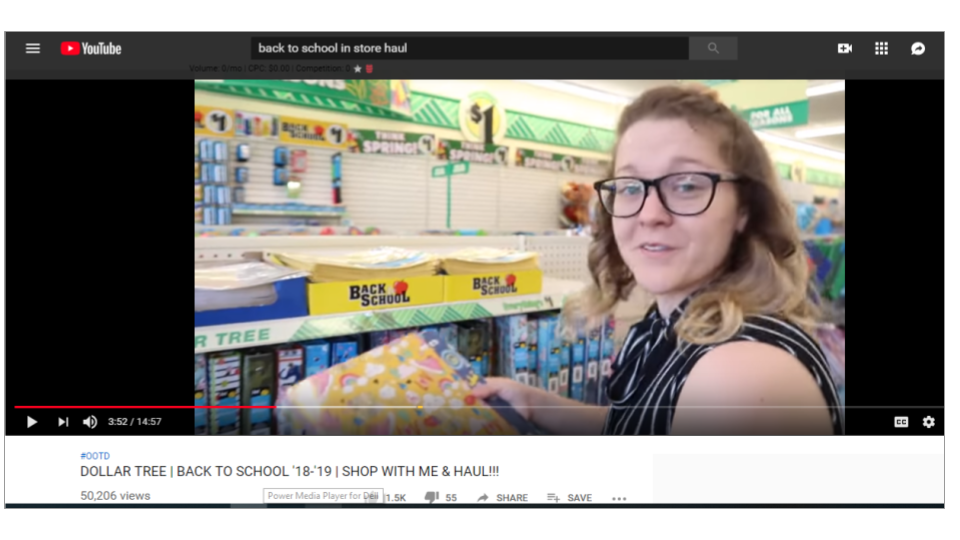
This is an in-store haul from Kieren of Thrifted Living. In-store video hauls are a great way to promote your physical location and give viewers and walk-through so they can see the selection for themselves. On YouTube.
If you take a quick look at the screenshot below of my Pinterest feed, you can see a lot of different verticals represented here. There are pins for educational printables, school supplies checklists, snack and lunch ideas, supplies kits, clothes, and a few other things that would naturally fall under the heading of back-to-school ideas.
BUT there are also topics you may not immediately recognize as back to school. For instance, half of back-to-college shoppers will be spending on furniture for on-and off-campus housing, to the tune of $3.5 billion. That makes total sense. But you may not know that 48 percent of moms also buy home organization items WHILE shopping for back-to-school things for their k-12 kids.
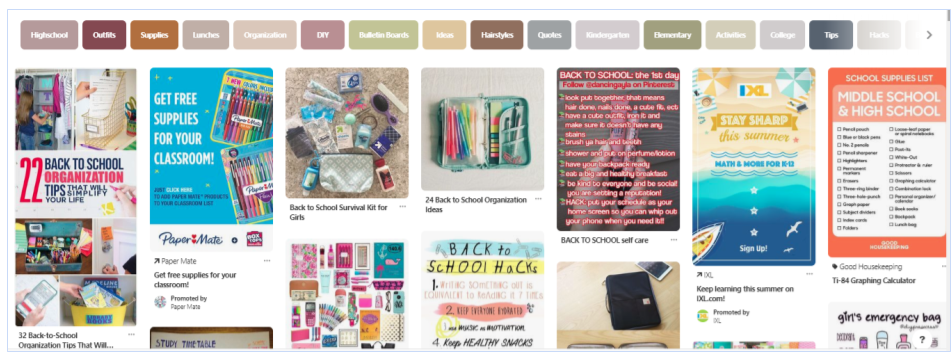
And you’ll notice there’s a pin on the far left that’s focused on home organization. There are tons of pins like this, both from bloggers and from brands. Bloggers will typically tell you how to do it while brands offer some visually-appealing inspirations for what to buy to get it done. You’ll want to be in both those categories.
With a compelling enough offer, you could also work the list-building angle. This one is really important because adding Mom to your email list will give you the chance to re-target her over the next few weeks when she’s actively involved in shopping. Send promo codes to her inbox. Forty-six percent of moms say they find discounts and promotions from brands for back-to-school shopping in their email inboxes.
Instagram is the main place students will want to hear from your brand. That’s true for promoted posts and it’s true for influencer campaigns.
If you go through your kid’s Instagram feed, there’s a good chance you’ll find quite a few sponsored posts from brands offering steep discounts to these kids in exchange for that all-important Shop Now click. Gen Zers have come to expect that. But targeting is really crucial here. Facebook / Instagram has some pretty legendary targeting capabilities to make sure your yoga block lands in the feed of high school dancers and aspiring contortionists instead of in the feed of a 16 year-old boy who’s obsessed with cars.
FYI: The yoga block example is an actual purchase my teenager made from a well-targeted sponsored post on Instagram. It was likely based on her affinity for, and engagement with, flexibility influencers. But in recent weeks, she’s also bought a charcoal face mask and a Curology subscription from Shop Now links on Instagram.
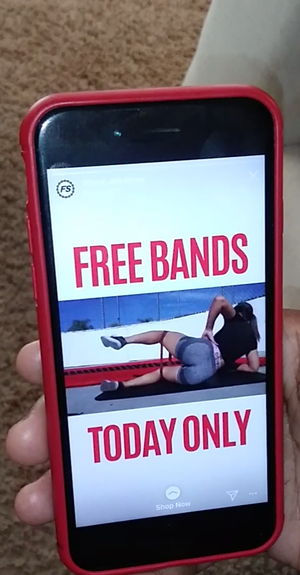
And these exercise bands
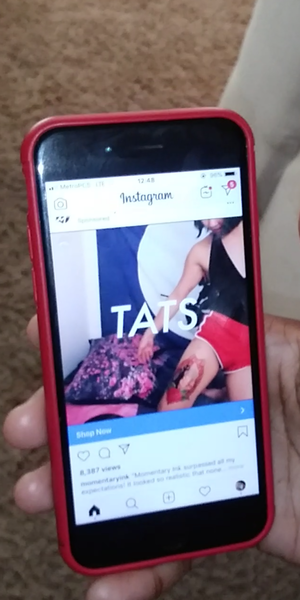
And these temporary tats
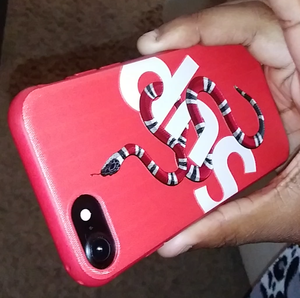
And this phone case…
In her own words, “If I see it on Instagram and I like it, I’m buying it. About half the stuff I buy is stuff from Instagram.”
#shrug
Who knew?
Phase III: Optimize and Promote
Before we land on the very last phase of your back-to-school campaign, I want to stop here to tell you to optimize. I mentioned optimization (testing your message to see what’s working) in Phase I, and in reality, we like to run influencer marketing campaigns where we are continually optimizing the campaign from start to finish. That means always monitoring the performance of each piece of content and making tweaks to get things to work better.
This is super important because many social media marketing campaigns, including influencer campaigns, benefit from a concurrent PPC campaign… things like boosting posts and putting more resources behind content from influencers whose posts are performing well.
In addition, working with creators provides brands the opportunity to store up gorgeous, high-impact user-generated content that the brand could then reuse across its own branded channels.
Phase IV: Consider Adding Video for Views and Conversions
Video is an effective method for marketing brands and products… but it can be expensive. So, there are really a couple of ways you can go about using video to stay top-of-mind, demonstrate the value of your product(s), and help your audience come to a final decision.
Video and pre-roll ads do VERY well on YouTube and Facebook. Unlike mid-roll ads, pre-roll ads are 3.5x less likely to be viewed as an interruption, according to a study by IPG Media Lab and YuMe.
Nielsen found that viewers who watched video ads for less than three seconds created up to 47 percent of total campaign value. Those who stayed tuned for up to 10 seconds accounted for 74 percent of total campaign value (72 percent for purchase intent).
Interestingly, even for pre-roll ads that were skipped, the impression of the ad still resulted in positive lift across several important metrics, including ad recall, brand awareness and purchase intent.
You can also partner with influencers to dream up some pretty creative back-to-school videos. For instance, I came across this from popular vlogger Wengie when I search “back to school” on YouTube.
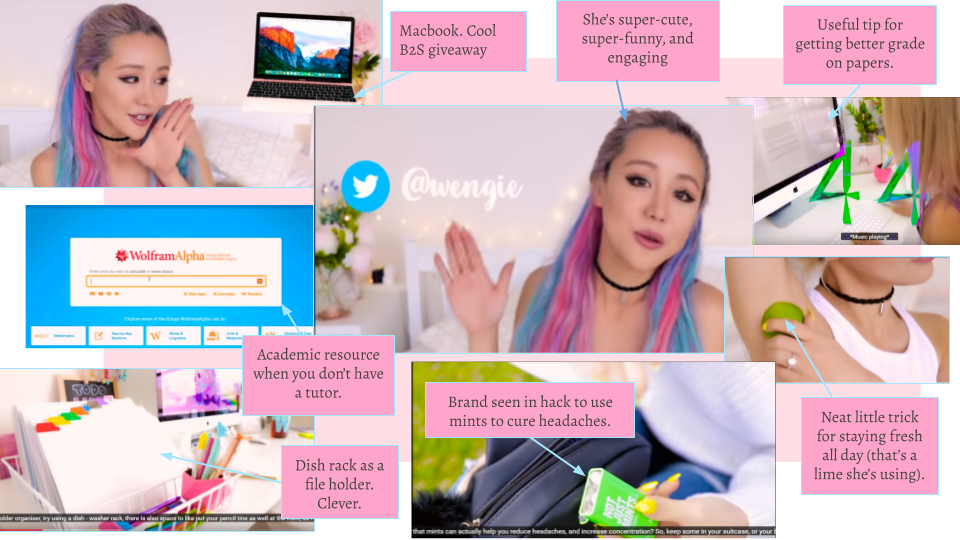
Source: On YouTube
Now, YouTube videos will typically be one of the pricier options for an influencer campaign, especially if you’re partnering with a macro-influencer. But these kinds of short, personal videos can get tons of eyes on your product.
In verticals like cosmetics, hair care, box subscription services, and gaming YouTube typically is a go-to platform for people to create and view that kind of content. Gen Zers use YouTube to learn stuff, but also it’s their last stop before they hit the stores.
To reduce the cost of a sponsored YouTube video, consider including your product as part of a larger list of gift ideas or hacks rather than choosing to have an influencer make an entire video strictly about your product.
Another thing to think about is basically just unraveling the traditional idea of product placement. Your product doesn’t have to be in the foreground to drive brand lift.
Consider two scenarios: A back-to-school post where an influencer and her friends are seen loaded with bags but the entire piece of content is about how great your chicken is. OR a day of shopping in which an influencer and her friends are out having a ball at the mall, trying on clothes, dreaming up homecoming ideas then stopping off at the food court to have some AMAZING chicken (and a plate of delicious sides for her vegan friend) before heading back out for shoes and makeup.
Both posts would include your food, but the second one is far less sponsored-looking… and people don’t like or respond to content that looks ultra-sponsored. Besides… who wants to watch somebody eat chicken for minutes?
My point is this: low-key product placements that enable an influencer to communicate having positive sentiment TOWARD your brand without having to verbally promote your brand will still help you stay top-of-mind. And be far more affordable.
Conclusion
Timing your back-to-school campaign is about more than just knowing when school starts, though that’s a crucial part of the planning process. Whether you are planning to target students, parents, or both, there are steps you can take to structure your campaign for maximum success.
And, of course, if you need help dreaming up creative, high-impact ideas for your next campaign, you can leave the influencer strategy to us. We can help your team craft AMAZING campaigns that actually deliver.

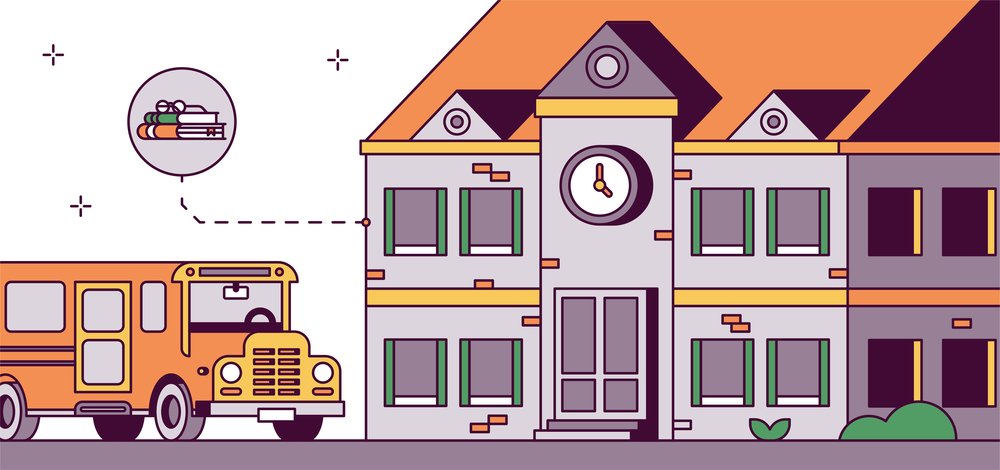




Leave a Reply